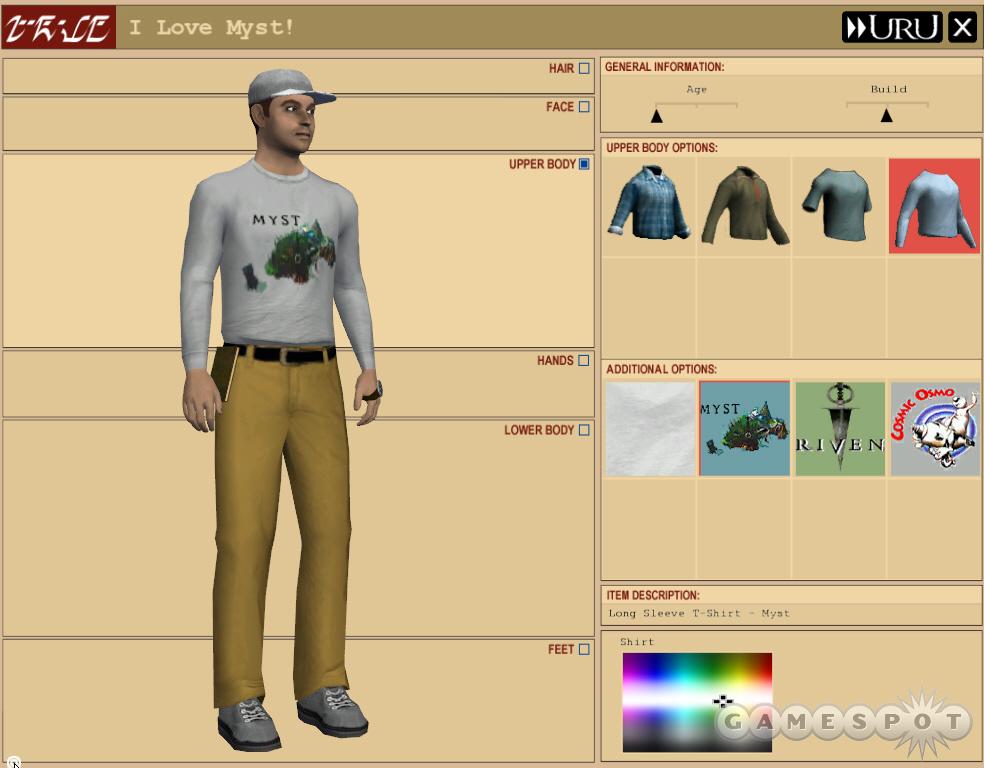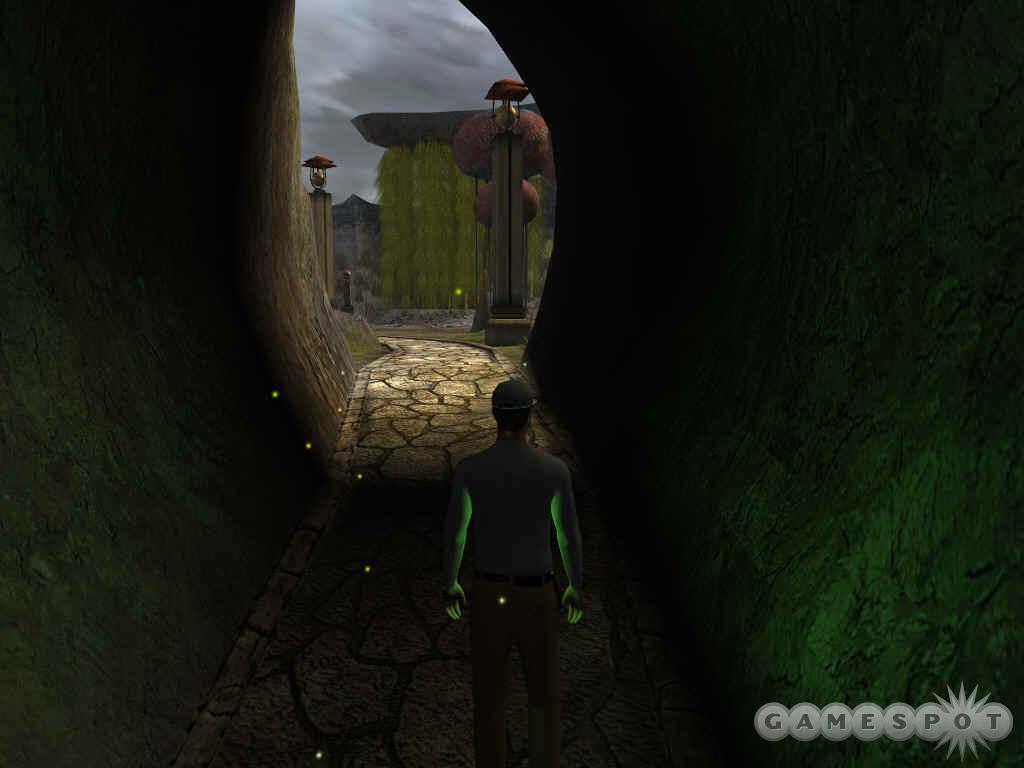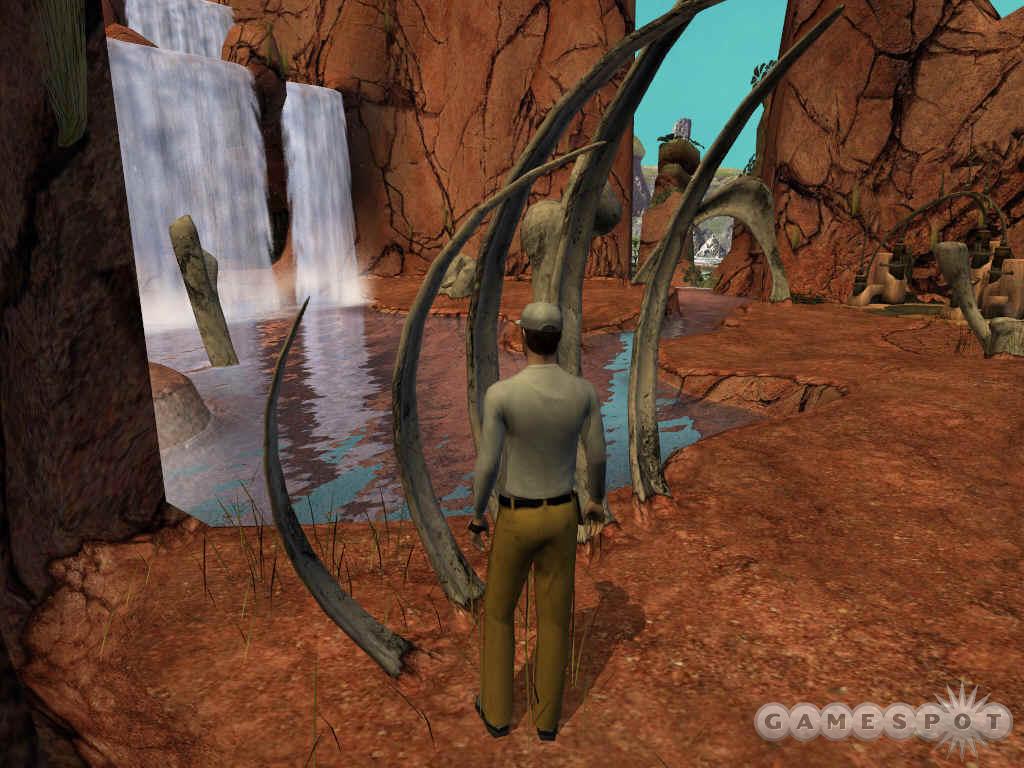Ten years ago, graphical adventure games were turned on their ear by Myst. Designers Robyn and Rand Miller produced a distinctive game in which you explored a colorful, fascinating world from a first-person perspective. For many, many people, Myst's intuitive, transparent interface and the highly realistic-looking yet fantastical environments were instantly captivating. Millions of sold copies and countless knockoff games later, Myst remains one of the most popular computer games of all time. Aside from being the first to popularize a first-person perspective in adventure games, Myst was also one of the first games to drive players to get CD-ROM drives. The latest game in the series, Uru: Ages Beyond Myst (formerly known as Myst Online), had originally been intended to add an all-new innovation to the genre: Uru Live, an online multiplayer version of the game. You were supposed to have been able to pick up Uru and play it over the Internet, exploring the ruins of the ancient D'ni civilization with thousands of other players. This online system was to include regular content updates featuring additional adventures and puzzles to be solved cooperatively with other players, as well as social elements, like the ability to create a virtual neighborhood with your friends.

However, this functionality wasn't available at the game's release and is still not widely available. It's being "tested" with small groups of players who are gradually being "invited" to play online on a trial basis--a puzzling development, especially since the game had previously featured a prerelease beta test, during which you could reasonably have expected developer Cyan Worlds and publisher Ubisoft to conduct and conclude such testing. The full-fledged online version will launch at an unspecified future date, so at and around the time of the game's release, your $50 gets you a single-player adventure game of about 10 to 15 hours in length and the ability to sign up for an invitation to play online someday (and, when that happens, pay monthly subscription fees to do so).
Fortunately, the single-player version of Uru is a very good game in its own right, despite being rather short. The fully 3D game lets you play as an explorer drawn to an excavation site at which the ruins of the lost D'ni civilization have been discovered. Using various tomes, you travel across four different realms, or "ages," to collect seven different parts of a magical symbol that must be compiled in order to complete your adventure in each age. To this end, Uru takes an unusual approach with its control scheme and presentation.
Uru is the first game in the series that lets you actually see your character from a third-person view--a character you generate at the start of the game by choosing your appearance and gender. This doesn't have much relevance in the single-player game, though having a unique-looking character may prove more significant in the multiplayer portion. Uru also has absolutely no inventory system--your character does not carry any items and therefore won't encounter any inventory-based puzzles (though there is one puzzle late in the game that requires you to carefully transport a swarm of glittering fireflies that "stick" to your character's body). The game also has hardly any interface elements. You carry the mystical Relto tome to return to your own personal hub area between the different ages, and you can pull up some game menu options, but these appear at the bottom of the screen as small icons and disappear by default so that your view of your surroundings is completely uncluttered.

As mentioned, your basic goal in each area is to find the seven parts of a hand-shaped symbol to complete your adventure in each area. These symbols are often hidden behind corners or obscured by environmental objects that must be moved (or moved to) by solving puzzles. Uru's puzzles are generally challenging, and it even has a few jumping puzzles, though you can't die--if you fall into a pit, for instance, you'll simply get whisked back to your hub area. To the game's credit, the puzzles at least start off simple, then become increasingly difficult. But toward the end, several of the game's logic-based puzzles require careful analysis and lots of trial and error--in some cases, to the point of being very, very annoying. This is especially true of the few physics-based puzzles that Uru has to offer--since you don't have an inventory in which to carry things, you're sometimes required to nudge nearby items (such as rocks, bones, and chairs) into certain positions. The game uses a control scheme reminiscent of a first-person shooter (you move by walking forward, walking backward, turning, and sidestepping), but it's too imprecise to handle nudging objects effectively. While solving these puzzles, you'll spend an undue amount of time coaxing objects into place while fervently wishing the control scheme weren't so clumsy or that you could just reach down, pick up that rock, and put it on the pressure plate yourself.
These puzzles may seem especially challenging to new players who are unfamiliar with the typically empty, mostly silent world of Myst games. Since you're exploring the ruins of an ancient culture, you're completely alone for most of your adventures. That means there are no helpful characters to provide tips, and the game has no in-game hint system either, so you'll usually walk into a room filled with strange symbols and be expected to figure out what to do next. You'll also find out about the game's story only through scattered journals and other writings you recover in different areas, though much of it deals with long-forgotten characters of the D'ni race--characters whose intricate and storied lives will probably seem completely meaningless to you if you're not already familiar with the series.
Beginners and veterans alike will appreciate Uru's exceptionally high production values. Using a careful eye, you can spot minor inconsistencies in Uru's visual presentation--the lack of ground shadows on your character, how tides of water in certain places clash without affecting each other, how a few textures (like the lava in a late-game area), don't look all that great, and how vegetation doesn't sway or react to the weather. If you look hard enough, you can even find a texture seam or two, and looking closely at several objects in the game reveals that they're composed of surprisingly few polygons. None of that significantly detracts from Uru's graphics, which are otherwise simply spectacular. Uru is all about its colorful and imaginative environments, which are uncluttered by any interface elements and adorned with incredibly clean textures and extremely well-done lighting effects that help bring these fantastic areas to life. Most of the game's areas are huge, though some are deceptively big--you'll encounter sprawling mountain valleys and huge lakes filled with mechanized equipment, but you won't be able to actually explore some of these, since you'll instead be restricted to a few narrow paths. Still, while Uru's general gameplay structure requires you to complete puzzles to progress, you probably won't be in that much of a hurry, especially when you first come up over a hill or down through a yawning cavern mouth to see yet another of the game's magnificent vistas.

Uru also sounds excellent. Though the game's ages are devoid of human life, and most of them aren't set to music, they are accompanied by completely appropriate, highly believable 3D sound. Winds blow across the flat desert at the beginning of the game, then take on a realistic howl as you descend into a rock formation. In a later area, the muted sounds of ambient wildlife perfectly complement the drifting leaves and soft light in a gigantic forest. Solving puzzles causes huge, rusted machines to grind convincingly into action, and waterfalls roar as you pass them, only to fade to a murmur as you leave them behind. As a result, Uru's beautiful environments aren't just showpieces--several of them practically seem like living, breathing places that you explore firsthand. Uru is also accompanied by a music track from pop musician Peter Gabriel, which plays during the ending credits, though this doesn't really add much to the game. Then again, Uru sounds superb without any additional help.
Depending on your familiarity with adventure games, Uru may take you as long as 10 to 15 hours to complete, though highly experienced adventure game fans will likely be able to finish the single-player game in even less than 10. Once you're through with the single-player game, you're through--the puzzles hold no replay value once you've figured them out, and your only incentive to replay the game is soaking in the sights and sounds again. In the meantime, you can join the others who bought the game in waiting for Uru Live to launch. It's too bad that the game shipped in an incomplete state, but at least the game you get in the box is worthwhile. Ultimately, Uru is a very good adventure game with impressive production values, but if it had actually shipped complete with the promised multiplayer, it perhaps could have been much more.